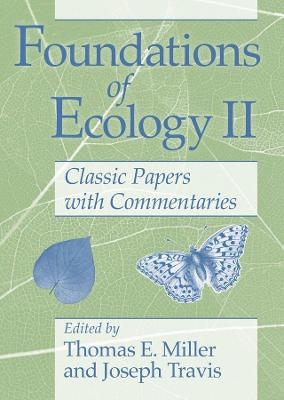
Foundations of Ecology II
University of Chicago Press (Verlag)
978-0-226-12536-7 (ISBN)
The period of 1970 to 1995 was a time of tremendous change in all areas of ecology—from an increased rigor for experimental design and analysis to the reevaluation of paradigms, new models for understanding, and theoretical advances. Edited by ecologists Thomas E. Miller and Joseph Travis, Foundations of Ecology II includes facsimiles of forty-six papers from this period alongside expert commentaries that discuss a total of fifty-three key studies, addressing topics of diversity, predation, complexity, competition, coexistence, extinction, productivity, resources, distribution, abundance, and conservation. The result is more than a catalog of historic firsts; this book offers diverse perspectives on the foundational papers that led to today’s ecological work. Like this book’s 1991 predecessor, Foundations of Ecology edited by Leslie A. Real and James H. Brown, Foundations of Ecology II promises to be the essential primer for graduate students and practicing ecologists for decades to come.
Thomas E. Miller is professor in the Department of Biological Science at Florida State University. He has authored over one hundred papers published in peer-reviewed outlets, with his work appearing in American Naturalist, Ecology, and Global Ecology and Biogeography. Joseph Travis is the Robert O. Lawton Distinguished Professor in the Department of Biological Science at Florida State University and the former editor of American Naturalist. He is coeditor of Evolution: The First Four Billion Years.
General Introduction
Joseph Travis, Thomas E. Miller, and F. Helen Rodd
Part One: Diversity and the Influence of Predators and Disturbance
Mark McPeek and Joseph Travis
Wilbur, H. M. 1972. Competition, predation, and the structure of the Ambystoma–Rana sylvatica community. Ecology 53: 3–21.
Lubchenco, J. 1978. Plant species diversity in a marine intertidal community: importance of herbivore food preference and algal competitive abilities. American Naturalist 112: 23–39.
Menge, B. A., and J. P. Sutherland. 1976. Species diversity gradients: synthesis of the roles of predation, competition, and temporal heterogeneity. American Naturalist 110: 351–369.
Dayton, P. K. 1971. Competition, disturbance, and community organization: the provision and subsequent utilization of space in a rocky intertidal community. Ecological Monographs 41: 351–389.
Connell, J. H. 1978. Diversity in tropical rain forests and coral reefs Science 199: 1302–1310.
Caswell, H. 1978. Predator-mediated coexistence: a nonequilibrium model. American Naturalist 112: 127–154.
Part Two: Competition, Coexistence, and Extinction
Thomas E. Miller and Greg Cooper
Vandermeer, J. H. 1969. The competitive structure of communities: an experimental approach with protozoa. Ecology 50: 362–371.
Armstrong, R. A., and R. McGehee. 1980. Competitive exclusion. American Naturalist 115: 151–170.
Tilman, D. 1977. Resource competition between planktonic algae: an experimental and theoretical approach. Ecology 58: 338–348.
Simberloff, D. S. 1970. Taxonomic diversity of island biotas. Evolution 24: 23–47.
Janzen, D. 1970. Herbivores and number of tree species in tropical forests. American Naturalist 104: 501–527.
Connell, J. H., and R. O. Slatyer. 1977. Mechanisms of succession in natural communities and their role in community stability and organization. American Naturalist 111: 1119–1144.
Sale, P. F. 1977. Maintenance of high diversity in coral reef fish communities. American Naturalist 111: 337–359.
Hubbell, S. 1979. Tree dispersion, abundance, and diversity in a tropical dry forest. Science 203: 1299–1309.
Part Three: Productivity and Resources
Robert W. Sterner and David M. Post
Schindler, D. W. 1977. Evolution of phosphorus limitation in lakes. Science 195: 260–262.
Rosenzweig, M. L. 1971. Paradox of enrichment: destabilization of exploitation ecosystems in ecological time. Science 171: 385–387.
McNaughton, S. J. 1979. Grazing as an optimization process: grass-ungulate relationships in the Serengeti. American Naturalist 113: 691–703.
Oksanen, L., S. D. Fretwell, J. Arruda, and P. Niemelä. 1981. Exploitation ecosystems in gradients of primary productivity. American Naturalist 118: 240–261.
Carpenter, S. R., J. F. Kitchell, J. R. Hodgson, P. A. Cochran, J. J. Elser, M. M. Elser, D. M. Lodge, D. Kretchmer, X. He, and C. N. von Ende. 1987. Regulation of lake primary productivity by food web structure. Ecology 68: 1863–1876.
Azam, F., T. Fenchel, J. G. Field, J. S. Gray, L. A. Meyer-Reil, and F. Thingstad. 1983. The ecological role of water-column microbes in the sea. Marine Ecology–Progress Series 10: 257–263.
Vitousek, P. M., and W. A. Reiners. 1975. Ecosystem succession and nutrient retention: a hypothesis. Bioscience 25: 376–381.
Part Four: Incorporating Trophic and Spatial Structure
Thomas E. Miller and Jordi Bascompte
Pimm, S. L. and J. H. Lawton. 1980. Are food webs divided into compartments? Journal of Animal Ecology 49: 879–898.
Polis, G. A. 1991. Complex trophic interactions in deserts: an empirical critique of food-web theory. American Naturalist 138: 123–155.
Bender, E. A., T. J. Case, and M. E. Gilpin. 1984. Perturbation experiments in community ecology: theory and practice. Ecology 65: 1–13.
Hanski, I. 1982. Dynamics of regional distribution: the core and satellite species hypothesis. Oikos 38: 210–221.
Pulliam, H. R. 1988. Sources, sinks, and population regulation. American Naturalist 132: 652–661.
Turner, M. G., R. V. O’Neill, R. H. Gardner, and B. T. Milne. 1989. Effects of changing spatial scale on the analysis of landscape pattern. Landscape Ecology 3: 153–162.
Part Five: Studies of Distribution and Abundance and the Rise of Conservation Ecology
Ben Bolker and Mary Ruckelshaus
Anderson, R., and R. M. May. 1978. Regulation and stability of host-parasite population interactions: I. Regulatory processes. Journal of Animal Ecology 47: 219–247.
Ludwig, D., D. D. Jones, and C. S. Holling. 1978. Qualitative analysis of insect outbreak systems: the spruce budworm and forest. Journal of Animal Ecology 47: 315–332.
Dennis, B., and M. L. Taper. 1994. Density dependence in time series observations of natural populations: estimation and testing. Ecological Monographs 64: 205–224.
Turchin, P., and A. D. Taylor. 1992. Complex dynamics in ecological time series. Ecology 73: 289–305.
Werner, P. A., and H. Caswell. 1977. Population growth rates and age versus stage-distribution models for teasel (Dipsacus sylvestris Huds.). Ecology 58: 1103–1111.
Crouse, D. T., L. B. Crowder, and H. Caswell. 1987. A stage-based population model for loggerhead sea turtles and implications for conservation. Ecology 68: 1412–1423.
Shaffer, M. L. 1981. Minimum population sizes for species conservation. BioScience 31:131–134.
Dennis, B., P. L. Munholland, and J. M. Scott. 1991. Estimation of growth and extinction parameters for endangered species. Ecological Monographs 61: 115–143.
Lande, R. 1993. Risks of population extinction from demographic and environmental stochasticity and random catastrophes. American Naturalist 142: 911–927.
Part Six: Evolutionary and Behavioral Ecology
Joseph Travis and F. Helen Rodd
Fretwell, S. D., and H. L. Lucas Jr. 1969. On territorial behavior and other factors influencing habitat distribution in birds I. Theoretical development. Acta Biotheoretica 19: 16–36.
Charnov, E. L. 1976. Optimal foraging: the marginal value theorem. Theoretical Population Biology 9: 129–136.
Grime, J. P. 1977. Evidence for the existence of three primary strategies in plants and its relevance to ecological and evolutionary theory. American Naturalist 111: 1169–1194.
Coley, P. D., J. P. Bryant, and F. S. Chapin III. 1985. Resource availability and plant antiherbivore defense. Science 230: 895–899.
Felsenstein, J. 1985. Phylogenies and the comparative method. American Naturalist 125: 1–15.
Herrera, C. M. 1992. Historical effects and sorting processes as explanations for contemporary ecological patterns: character syndromes in Mediterranean woody plants. American Naturalist 140: 421–446.
Lande, R., and S. J. Arnold. 1983. The measurement of selection on correlated characters. Evolution 37: 1210–1226.
Berenbaum, M. R., A. R. Zangerl, and J. K. Nitao. 1986. Constraints on chemical coevolution: wild parsnips and the parsnip webworm. Evolution 40: 1215–1228.
Werner, E. E., J. F. Gilliam, D. J. Hall, and G. G. Mittelbach. 1983. An experimental test of the effects of predation risk on habitat use in fish. Ecology 64: 1540–1548.
Addicott, J. F. 1986. Variation in the costs and benefits of mutualism: the interaction between yuccas and yucca moths. Oecologia 70: 486–494.
Index
| Erscheinungsdatum | 17.08.2022 |
|---|---|
| Zusatzinfo | 1 halftones |
| Sprache | englisch |
| Maße | 152 x 229 mm |
| Gewicht | 1306 g |
| Themenwelt | Naturwissenschaften ► Biologie ► Ökologie / Naturschutz |
| Naturwissenschaften ► Geowissenschaften ► Geologie | |
| ISBN-10 | 0-226-12536-X / 022612536X |
| ISBN-13 | 978-0-226-12536-7 / 9780226125367 |
| Zustand | Neuware |
| Informationen gemäß Produktsicherheitsverordnung (GPSR) | |
| Haben Sie eine Frage zum Produkt? |
aus dem Bereich


